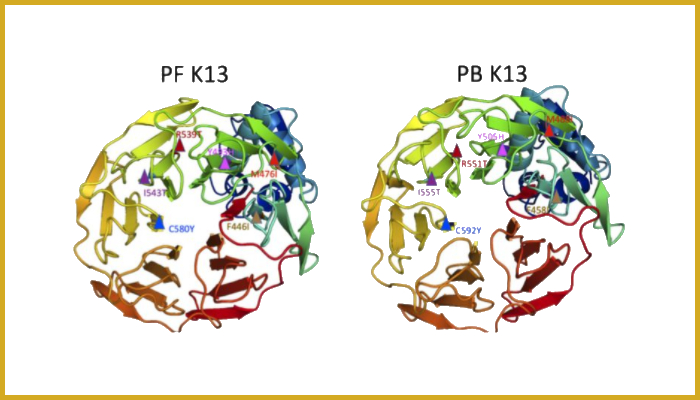P. berghei K13 Mutations Mediate Artemisinin Resistance Reversed by Proteasome Inhibition
Published: 25 January 2021
Research by Institute scientists has established the rodent model of malaria, P. berghei, as a useful tool to study the impact and biology of human parasite mutations on the outcome of infection and evolution of drug resistance.

Institute scientists have established the rodent model of malaria, Plasmodium berghei, as a useful tool to study the impact and biology of human parasite mutations on the outcome of infection and evolution of drug resistance.
Conducted and led at the University of Glasgow by Dr Nelson Simwela and in part collaboration with the Columbia University in New York, a selection of the research was recently published in mBio.
In their paper, Dr Simwela and colleagues show that the introduction of orthologous mutations associated with human malaria resistance into parasite P. berghei allows confirmation of the impact of the mutation on resistance in an animal model, opening the door to more detailed investigation and assessment of its impact on pathology and transmission.
Recent successes in malaria control have been seriously threatened by the emergence of Plasmodium falciparum parasite resistance to the front-line antimalarial drug artemisinin drugs, particularly in most parts of Southeast Asia
The primary mediator of that artemisinin resistance has been shown to be mutations in a single protein Kelch13 (K13), which is involved in the transport of host red cell haemoglobin into the parasite’s food vacuole (FV).
Haemoglobin is digested in the FV to provide amino acids that the parasite can use to synthesis its own proteins and grow.
The role of K13 mutations in artemisinin resistance has been demonstrated in vitro - under lab conditions - and they are strongly associated with artemisinin resistance in clinical samples.
However, their direct role in actual human infections is difficult to establish as resistance appears to involve only a very brief period of reduced susceptibility in young parasites until the short-lived - hours - artemisinin is cleared from the bloodstream. No suitable and easily accessible animal model was available to complement these clinical observations and laboratory work.
In their recent studies, Dr Simwela at al have shown that K13 polymorphisms mediate artemisinin resistance in in vivo conditions in the rodent model of malaria, P. berghei. Mutations in proteins other than K13 might also contribute to human parasite resistance to artemisinin.
In a second study, they linked artemisinin resistance to changes in another protein (UBP-1) belonging to a large group of proteases of the ubiquitin hydrolase family that are involved in protein recycling in the cell.
In two publications (PMID: 33173001, 32340987), the scientists used powerful genome editing (CRISPR-Cas9) to introduce the candidate artemisinin resistance mutations in the equivalent genes in P. berghei.
This allowed them to characterise and confirm artemisinin resistance properties both in culture but more importantly also in vivo, something that is ethically and experimentally impossible with P. falciparum and human infections.
They also demonstrated two different adjunct therapies that could reverse artemisinin resistance in vivo (PMID: 33173001, 33400499).
Overall, the work establishes the P. berghei model as a useful tool to study the impact and biology of human parasite mutations on the outcome of infection and evolution of drug resistance.
Andy Waters, Professor in Biomedical and Life Sciences (Parasitology) and co-author on the paper, said: "Nelson has achieved a tremendous amount in his time working on antimalarial drug resistance, not least his recent PhD in December.
"He has established the principle that the introduction of orthologous mutations associated with human malaria resistance into the rodent parasite, P. berghei, allows confirmation of the impact of the mutation on resistance in an animal model.
"It opens the door to more detailed investigation and assessment of its impact on pathology and transmission."
Image Legend | Figure 1A: Introduction of orthologous K13 nucleotide substitutions in P. berghei. (A) Three-dimensional homology model of P. falciparum (PF3D7_1343700) and P. berghei (PBANKA_1356700) K13 for amino acid residues 350 to 726 and 362 to 738, respectively. P. falciparum K13 mutation sites (F446I, M476I, Y493H, R539T, I543T, and C592Y) are indicated in the structure on the left, and P. berghei orthologous mutation sites are modeled on the right. Models were created in SWISS-MODEL using PDB template 4zgc.1.A. Structures were visualized and annotated using PyMOL 2.3
First published: 25 January 2021
Related Links
- Dr Nelson Simwela profile
- Professor Andy Waters profile
- Wellcome Centre for Integrative Parasitology (WCIP)
- Columbia University
- Read the research article in mBio
- Experimentally Engineered Mutations in a Ubiquitin Hydrolase, UBP-1, Modulate In Vivo Susceptibility to Artemisinin and Chloroquine in Plasmodium berghei
- Mammalian Deubiquitinating Enzyme Inhibitors Display in Vitro and in Vivo Activity against Malaria Parasites and Potentiate Artemisinin Action

